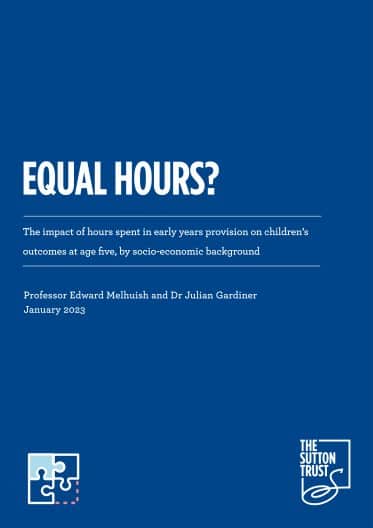Impact of early years provision by socio-economic group
- For children from disadvantaged families (those in the lowest 40% of the income distribution), there are benefits for cognitive development associated with early childhood education and care usage between the ages of 3 and 5 years. These benefits are on average substantially greater if the provision is of high quality.
- For children in more advantaged families (the upper 60% of the income distribution) early childhood care and education is less important than for disadvantaged children. For better off children, outcomes from attendance are more mixed, with both positive and negative associations, although there are fewer negative impacts for this group when provision is of high quality.
- There are some socio-emotional benefits but also some socio-emotional drawbacks linked with formal group early childhood education and care usage. The drawbacks largely concern externalising (or antisocial) behaviour. The association with externalising behaviour, behavioural self-regulation and emotional self-regulation is strong for better off children, whereas for internalising behaviour (children becoming easily upset or anxious) the association is stronger for disadvantaged children.
- However, these drawbacks are not found for disadvantaged children in high quality provision. It is also reduced, even at high levels of attendance, when a child is in a mix of individual and group provision.
- Disadvantaged children benefit more from early childhood care and education when attending with children from a mix of socio-economic backgrounds, likely due to a peer influence operating for both children and parents.
Time in early childhood education and care
- Most of the negative impacts seen for externalising behaviour of more time in an early years setting are already seen by the time a child is in provision for 15 hours a week. Increasing hours beyond 15-20 per week does not appear to further increase externalising behaviour, except for non-disadvantaged children, and only if in provision for 35 hours or more per week.
- For disadvantaged children, there are no significant differences in socio-emotional outcomes between those in formal early years provision for 15 to 20 hours per week and children who attended for a higher number of hours.
- There will be little extra benefit to children’s development of early years provision of greater duration than 15-20 hours per week, but if the provision is of high quality, there are unlikely to be adverse effects for disadvantaged children, and longer hours could bring wider benefits to families (e.g. by allowing parents to work).
Importance of the home learning environment
- A high quality home learning environment is beneficial for children, with higher family home learning environment (HLE) scores associated with better verbal ability at age 5 for both disadvantaged and better-off children.
- For disadvantaged children, a better home learning environment is associated with better behavioural self-regulation at age 5 and can also help to prevent the poorer socio-emotional outcomes which are otherwise associated with high use of lower quality early years provision.
